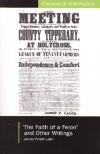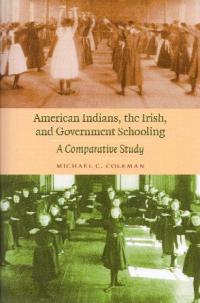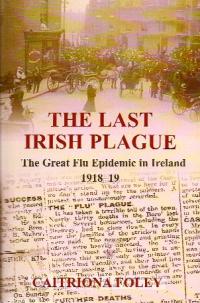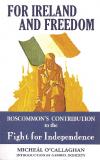Bookworm
Published in Book Reviews, Issue 6 (Nov/Dec 2012), Reviews, Volume 20 Bookworm is looking forward to Christmas, and a number of series from Irish publishers present a few ideas for stocking-fillers. First up is UCD Press. The latest in their ‘Classics of Irish History’ series is a new edition of the collected writings of the Young Irelander James Fintan Lalor: ‘The faith of a felon’, and other writings (160pp, €20, ISBN 9781906359263), edited and introduced by Marta Ramón. Lalor is one of the more influential of Irish nationalist thinkers, most especially in terms of his radical analysis of the land question; Michael Davitt and Patrick Pearse were amongst his diverse admirers. But Ramón also makes a case for rediscovering Lalor as one of the great political polemicists of nineteenth-century Ireland. Readers can now decide for themselves.
Bookworm is looking forward to Christmas, and a number of series from Irish publishers present a few ideas for stocking-fillers. First up is UCD Press. The latest in their ‘Classics of Irish History’ series is a new edition of the collected writings of the Young Irelander James Fintan Lalor: ‘The faith of a felon’, and other writings (160pp, €20, ISBN 9781906359263), edited and introduced by Marta Ramón. Lalor is one of the more influential of Irish nationalist thinkers, most especially in terms of his radical analysis of the land question; Michael Davitt and Patrick Pearse were amongst his diverse admirers. But Ramón also makes a case for rediscovering Lalor as one of the great political polemicists of nineteenth-century Ireland. Readers can now decide for themselves.
The land question in nineteenth-century Ireland was ultimately intertwined with that of Home Rule. If Lalor’s influence was so important in terms of the former, it is appropriate that UCD Press should also give us an updated biography of the most important Home Ruler of them all: Alan O’Day’s Charles Stewart Parnell (144pp, €17, ISBN 9781906359331). This is not the first revised study of the dead chief to appear in recent times (see Paul Bew’s Enigma, reviewed in our May/June 2012 issue). O’Day’s work was first published in the Historical Association of Ireland’s ‘Life and Times’ series, recently relaunched by UCD press. As well as new biographies, they are publishing new editions of some of the originals. The most recent addition to the series also falls into that category and is a study of Parnell’s successor as leader of the Home Rule party: Eugene J. Doyle, Justin McCarthy (128pp, €17, ISBN 9781906359683).
 In recent times Mercier Press have effectively launched a series of their own by republishing accounts of the Irish Revolution that appeared between the 1940s and the 1960s. The latest is Micheál O’Callaghan’s For Ireland and freedom: Roscommon’s contribution to the fight for independence (222pp, €14.99, ISBN 9781781170588). O’Callaghan’s book, originally published in 1964, arose from his involvement in compiling a centenary edition of the Roscommon Herald (he served as editor of the paper). The midlands were one of the hotbeds of the independence struggle; indeed, the first real measure of Irish public opinion after the Easter Rising came with the North Roscommon by-election of 1917, won by Joseph Plunkett’s father on a Sinn Féin ticket. In his introduction Gabriel Doherty makes a case for looking at the struggle for independence as almost a ‘people’s war’, in the sense that without some kind of active or passive ‘public support’ for the republican cause—as suggested by the election of Plunkett—the IRA could not have had the degree of success they achieved.
In recent times Mercier Press have effectively launched a series of their own by republishing accounts of the Irish Revolution that appeared between the 1940s and the 1960s. The latest is Micheál O’Callaghan’s For Ireland and freedom: Roscommon’s contribution to the fight for independence (222pp, €14.99, ISBN 9781781170588). O’Callaghan’s book, originally published in 1964, arose from his involvement in compiling a centenary edition of the Roscommon Herald (he served as editor of the paper). The midlands were one of the hotbeds of the independence struggle; indeed, the first real measure of Irish public opinion after the Easter Rising came with the North Roscommon by-election of 1917, won by Joseph Plunkett’s father on a Sinn Féin ticket. In his introduction Gabriel Doherty makes a case for looking at the struggle for independence as almost a ‘people’s war’, in the sense that without some kind of active or passive ‘public support’ for the republican cause—as suggested by the election of Plunkett—the IRA could not have had the degree of success they achieved.
The Irish Revolution was not just about the IRA, but one would not get that impression from Gerry Hunt’s graphic novel At war with the Empire: Ireland’s fight for Independence (O’Brien Press, 64pp, €12.99, ISBN 9781847172600). It is interesting to put these two books, published over 50 years apart, side by side. As Doherty observes of O’Callaghan’s book, ‘despite the stereotypical labels attached to such works by historians frequently too lazy to actually read them . . . the book contains quite a number of comments frankly critical of certain activities of the separatist movement’. But sophistication is absent from Hunt’s clunky and militaristic work (in fairness, he does acknowledge the ruthlessness of the IRA alongside that of their opponents), and while it might engage younger readers it ultimately obscures far more than it explains.
 Militarism is not confined to republicans. Bookworm was always bemused by the unabashed militarism of some of the monuments in St Patrick’s Cathedral. But Albert Fenton’s Past lives: the memorials of Saint Patrick’s Cathedral, Dublin (St Patrick’s Cathedral, 200pp, ISBN 9780956217325) does begin by noting that ‘it is unfortunate that two of the finest monuments in the cathedral are memorials to the British Empire’s most unforgivable wars [China and Burma]. Indeed, the China War, also called the Opium War, was one of the most sordid and vicious events in the history of the Empire’. No surprise, then, to find that the book goes on to provide a fascinating warts-and-all guide to the huge variety of memorials that adorn this most interesting of buildings.
Militarism is not confined to republicans. Bookworm was always bemused by the unabashed militarism of some of the monuments in St Patrick’s Cathedral. But Albert Fenton’s Past lives: the memorials of Saint Patrick’s Cathedral, Dublin (St Patrick’s Cathedral, 200pp, ISBN 9780956217325) does begin by noting that ‘it is unfortunate that two of the finest monuments in the cathedral are memorials to the British Empire’s most unforgivable wars [China and Burma]. Indeed, the China War, also called the Opium War, was one of the most sordid and vicious events in the history of the Empire’. No surprise, then, to find that the book goes on to provide a fascinating warts-and-all guide to the huge variety of memorials that adorn this most interesting of buildings.
There are now 105 Maynooth Studies in Local History, published by Four Courts Press. The century mark was reached with Bernadette Cunningham’s brisk study of Clanricarde and Thomond, 1540–1640: provincial politics and society transformed (72pp, €9.95, ISBN 9781846823527). The other titles in the latest batch deal with the nineteenth and twentieth centuries: Ciarán Reilly, John Plunket Joly and the Great Famine in King’s County (56pp, €9.95, ISBN 9781846823558); Catherine Fleming, The transportation of women from Kildare to Van Diemen’s Land in 1849 (56pp, €9.95, ISBN 9781846823565); Mary Delaney, William Steuart Trench and his management of the Digby estate, King’s County (56pp, €9.95, ISBN 9781846823534); Joe Mooney, The changing fortunes of the Headfort estates, 1870–1928 (72pp, €9.95, ISBN 9781846823541); and Patrick Cosgrove, The Ranch War in Riverstown, Co. Sligo, 1908 (64pp, €9.95, ISBN 9781846823572).
 These studies deal with the period that saw the virtual extinction of the Irish landed gentry, but the economist Peter Bacon looks at what that ‘gintry’ sometimes did in their leisure time: his Land, lust, and gunsmoke: a social history of game shoots in Ireland (The History Press Ireland, 320pp, €50, ISBN 9781845887179) is a fascinating, unsentimental and beautifully produced work that covers far more than its title implies. Bacon’s role as the chairman of the Countryside Alliance Ireland guarantees a thought-provoking commentary on the ecologies of game shooting, though his role as one of the architects of what became NAMA is reflected in observations such as: ‘the landed gentry of the late nineteenth century were about as solvent as the property development class in Ireland a centry later. However, they still attempted to maintain the lifestyle and consumption patterns of better times. Sound familiar?’
These studies deal with the period that saw the virtual extinction of the Irish landed gentry, but the economist Peter Bacon looks at what that ‘gintry’ sometimes did in their leisure time: his Land, lust, and gunsmoke: a social history of game shoots in Ireland (The History Press Ireland, 320pp, €50, ISBN 9781845887179) is a fascinating, unsentimental and beautifully produced work that covers far more than its title implies. Bacon’s role as the chairman of the Countryside Alliance Ireland guarantees a thought-provoking commentary on the ecologies of game shooting, though his role as one of the architects of what became NAMA is reflected in observations such as: ‘the landed gentry of the late nineteenth century were about as solvent as the property development class in Ireland a centry later. However, they still attempted to maintain the lifestyle and consumption patterns of better times. Sound familiar?’
Finally, mention should be made of Des O’Hagan’s Letters from Long Kesh (Citizen Press, 130pp, €10, ISBN 9780957283503). Belfast native O’Hagan was a founder member of the Northern Ireland Civil Rights Association and went on to become a stalwart of the Workers’ Party: he was amongst the first to be detained when the British reintroduced internment to Northern Ireland in 1971. The letters, written in captivity, smuggled out by his wife and originally published in the Irish Times, offer a vivid and penetrating account of a key episode in the ‘Troubles’. HI
















